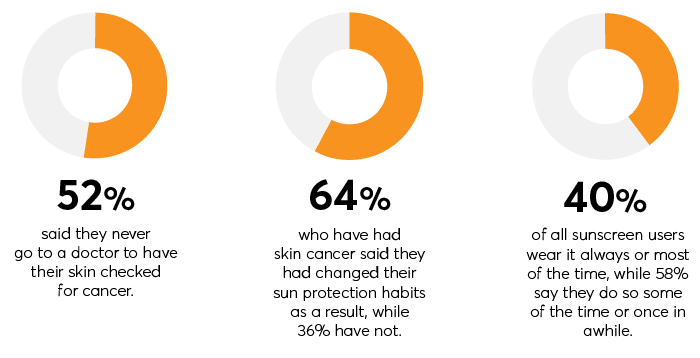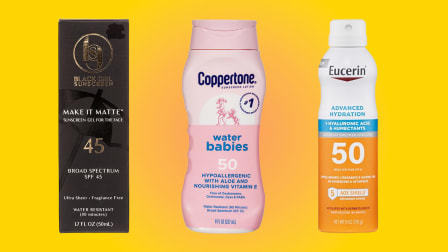Sun Safety Tips for the Entire Family
We answer your burning questions on sunscreens and the best ways to minimize your risk of skin cancer and skin damage
When you shop through retailer links on our site, we may earn affiliate commissions. 100% of the fees we collect are used to support our nonprofit mission. Learn more.

More than one in 4 Americans (28 percent) never wears sunscreen, according to a new Consumer Reports nationally representative survey of 2,007 U.S. adults. And most of the people who say they do wear it don't do so every time they're in the sun. That's concerning, because avoiding unprotected exposure to ultraviolet rays is probably the most effective way to keep your skin healthy.
One possible reason consumers don't shield their skin the way they should is because of confusion about how to choose and use sunscreen and other sun protection measures. Here, experts answer some of the most common questions and provide sun safety tips for you and your family.
What Type of Sunscreen Gives the Best Protection?
Sunscreens that contain chemical ingredients—avobenzone, octisalate, or oxybenzone, for example—have been found by CR to be the most effective. They protect skin from the kind of sun damage that can cause burning, wrinkles, and skin cancer by absorbing energy from the sun’s ultraviolet (UV) rays and preventing them from penetrating skin. All of CR’s top-rated sunscreens are chemical-based. But there has been controversy in the past few years over the safety of these sunscreens, because research has shown that the chemicals can soak into the skin and bloodstream.
This has raised some concerns, and the Food and Drug Administration recently asked sunscreen manufacturers to provide more information on the safety of these chemicals. But the FDA stresses that this request doesn’t mean that the ingredients are unsafe.
“We need additional data in order to fully understand the long-term effect of absorption and what levels can be considered safe,” says David Strauss, M.D., Ph.D., director of the division of applied regulatory science for the Center for Drug Evaluation and Research at the FDA, who has studied the absorption of these chemicals.
Aren’t There Effective Sunscreens That Don’t Use Chemicals?
You could switch to “mineral” sunscreens, which pose no known safety risks, according to the FDA. These products contain titanium dioxide and zinc oxide, which “sit on top of the skin, blocking UV rays without being absorbed,” says Joshua Zeichner, M.D., director of cosmetic and clinical research in dermatology at Mount Sinai Hospital in New York City. “They’re also less likely to irritate delicate skin, which is why they’re recommended for babies and young children.” And because the American Academy of Pediatrics currently advises parents to avoid using sunscreens with oxybenzone on children due to the aforementioned concerns, mineral sunscreens would seem like a good choice for kids.
But there’s a hitch: In CR’s tests, mineral sunscreens don’t do as good a job of shielding skin as chemical sunscreens. “Over the last eight years of testing, we haven’t had a mineral sunscreen come in anywhere near the top of our ratings,” Huber says. “What we see is that some provide adequate SPF protection against sunburn-causing UVB rays, but they aren’t so great against the UVA rays that contribute to skin cancer and skin aging—or vice versa.”
If you still prefer a mineral product, consider California Kids #supersensitive Tinted Lotion SPF 30+ and Badger Active Natural Mineral Cream SPF 30 Unscented. While these sunscreens didn’t come in at the top of our ratings, they both received Good scores. (Note that adults can use formulations made for children.)
Are “Reef Safe” Sunscreens Really Less Harmful to Oceans?
They may be, although the term “reef safe” isn’t regulated. More scientists are focusing on the environmental impact of sunscreens, particularly those with oxybenzone, a highly effective UV filter. (In fact, all of the top-rated sunscreens in our tests contain it.) Studies have found concentrations of oxybenzone high enough in some ocean waters to interfere with the reproductive systems of fish and destroy coral reefs. For this reason some areas, such as Hawaii, Key West in Florida, and the U.S. Virgin Islands, currently ban (or plan to ban by 2021) sunscreens that contain it. In some cases, sunscreens with the chemicals octocrylene and octinoxate are also being banned.
Many sunscreens have been reformulated to remove one or more of these chemicals. They include some that were top-rated in our previous tests, such as La Roche-Posay Anthelios 60 Melt-In Sunscreen Milk and Equate (Walmart) Ultra Lotion SPF 50. But we couldn’t get the new products in time to include in this year’s testing, so we weren’t able to gauge how they rate now.
Four products that scored Very Good ratings don’t contain oxybenzone or octinoxate but do have octocrylene. They’re all from Hawaiian Tropic: Sheer Touch Ultra Radiance Lotion SPF 50 and SPF 30, Silk Hydration Weightless Lotion SPF 30, and Island Sport Ultra Light Spray SPF 30.
Is Wearing Sunscreen While Indoors Overdoing It?
No. Although even plain untinted glass blocks most UVB rays, more than 50 percent of UVA rays can still penetrate your skin through home or office windows. So if you sit all day close to a window that doesn’t have UV protective film, you might want to use sunscreen on exposed skin. Getting sun damage in a car is also possible. The kind of glass used in front windshields and some sunroofs blocks a majority of both types of UV rays, but side windows let UVA rays pass through unless they’re tinted.
Dark-Skinned People Don’t Need to Use Sunscreen, Right?
Wrong. But it’s a common misconception. In CR's survey, just 39 percent of African Americans said they ever used sunscreen, compared with 77 percent of Latinos and whites. People of color have more of the skin pigment melanin, which provides some natural UV protection. But they can still get sunburn and skin cancer. The melanoma rate is 28 in 100,000 for whites, and while lower, it’s still 5 in 100,000 for Latinos and 1 in 100,000 for African Americans, according to the American Cancer Society.


Do You Need a Separate Sunscreen for Your Face?
Not from a sun protection perspective. Facial sunscreens (and moisturizers with SPF) are held to the same standards for safety and effectiveness as other sunscreens. But you might want a face formulation if you have oily, acne-prone, or easily irritated skin. “Sunscreens designed for the face are often oil-free, lighter, and won’t block pores,” says Rebecca Hartman, M.D., M.P.H., director of melanoma epidemiology at Brigham and Women’s Hospital in Boston. That means they’ll work well under makeup or over facial stubble.
Are Sunscreens for Kids and Babies Different From Products for Adults?
Generally speaking, no. The FDA doesn’t regulate sunscreens for children any differently from those for adults; all are required to meet the same criteria for safety and effectiveness. Those labeled for babies or kids may have a different fragrance or be less irritating to delicate skin by having more mineral ingredients (zinc oxide or titanium dioxide) than chemical ones. But an adult can use a sunscreen labeled for kids and vice versa.
Is It Okay to Use Sunscreen From Last Summer?
It depends. "Heat accelerates sunscreen breakdown," says Susan Booth, who oversees CR's sunscreen testing. "If the bottle has been in your car or in a beach bag in your garage, temperature fluctuations may have affected it." But even when properly stored, sunscreen won't be effective after three years. Check the expiration date, but if the bottle doesn't have one, and you can't recall when you bought it, it's time to pick up a new bottle.
What Does CR Recommend for People Who Don't Like the Feel or Smell of Many Sunscreens?
Some do feel better on your skin and don’t have an overpowering scent, our professional sensory testers say. If you want to avoid the greasy, tacky feel of some sunscreens, we suggest Coppertone Ultra Guard Lotion SPF 70 or Hawaiian Tropic Island Sport Ultra Light Spray SPF 30. As for scent, Ultra Guard is barely noticeable, and Island Sport has a faint tropical aroma.
The Right Way to Wear Sunscreen
Applying sunscreen carelessly will deprive you of its benefits. Play by the rules:
• Always choose an SPF of 30 or higher.
• Select a “broad spectrum” sunscreen, which protects against both UVA and UVB rays.
• Check the expiration date. Sunscreens are effective for 3 years.
• Apply sunscreen at least 15 minutes before heading outside.
• Use at least 1 ounce; that’s about a shot-glass worth, enough to cover the entire body of most adults when in a bathing suit. If wearing clothing, use 1 teaspoon per uncovered body part.
• Reapply the same amount every 2 hours or immediately after swimming or sweating.
• Pay attention to commonly missed spots: the backs of your hands, the tops of your feet, your ears, and the back of your neck. Wear a hat to protect your scalp if you don’t want to use sunscreen there.
If you use a spray, hold the nozzle an inch away from your skin, spray until your skin glistens, and then—yes—rub the sunscreen in to ensure even coverage. When using a spray outdoors, make sure the aerosol isn’t being blown away by the wind. And don’t spray directly onto your face, because inhaling sunscreen could harm your lungs.
Editor’s Note: This article also appeared in the July 2020 issue of Consumer Reports magazine.




















